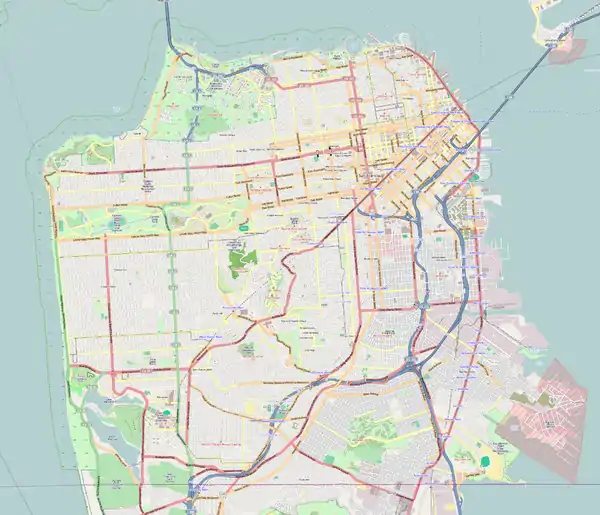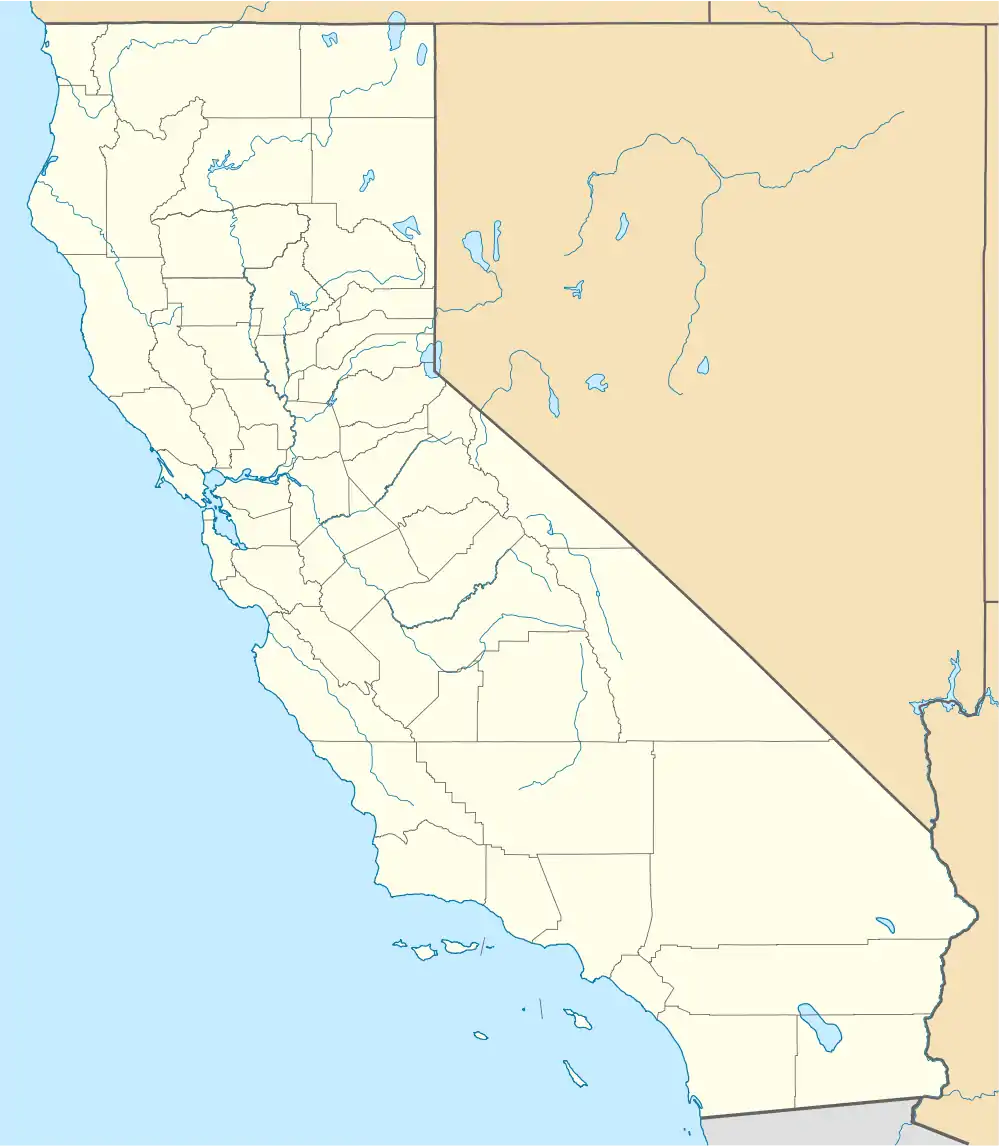| California Hall | |
|---|---|
 | |
| Location | 625 Polk Street, San Francisco, California, U.S. |
| Coordinates | 37°46′57″N 122°25′09″W / 37.782455°N 122.419220°W |
| Built for | German Association |
| Architect | Frederick Herman Meyer[1] |
| Architectural style(s) | German Baroque[1] |
| Designated | October 7, 1984[2] |
| Reference no. | 174 |
 Location of California Hall in San Francisco County  California Hall (San Francisco, California) (California) | |
California Hall, originally named Das Deutsches Haus (English: The German House), is a historic commercial building and event venue built in 1912, and located in the Polk Gulch/Tenderloin neighborhood in San Francisco, California.[3] It started as a German social meeting hall.[1] At the 1965 Year Years Ball, a fundraiser took place in the building for many gay charities, and brought trouble with the police and a legal battle. The event marked a turning point in gay rights in the west coast.[4] It later was a popular concert hall in the mid-1960s and 1970s; performers that played at the California Hall include Jefferson Airplane, Moby Grape, Big Brother and the Holding Company, the Grateful Dead, and Quicksilver Messenger Service.[5]
The building presently is part of the Academy of Art University campus. The California Hall has been listed as a San Francisco Designated Landmark since October 7, 1984.[6][2]
History
In 1912, when the Das Deutsches Haus was built, Polkstrasse (now Polk Street) was a main commercial shopping center for German immigrants.[3][7] The architect was Frederick H. Meyer and the design of the building was influenced by the Heidelberg Castle in Heidelberg, Baden-Württemberg, Germany.[3][1] There was a restaurant in the basement called the Rathskeller.[8]
It was originally used as a meeting space by 43 German societies and fraternities.[8] During World War I, the build name was changed to California Hall.[8] German American Bund, a Nazi organization for Americans of German-descent, had held meetings in the building prior to World War II.[8]
The building was featured in the action movie, Dirty Harry (1971).[5] The building previously housed the California Culinary Academy,[9] and it is presently part of the Academy of Art University campus.
1965 New Years Ball
In the 1950s gay men started to visit Polk Street, specifically the area near California Hall in Lower Polk.[10] The 1965 New Years Ball (a fundraiser for the Council on Religion and the Homosexual, and other homophile organizations) was held January 1, 1965 at the California Hall.[10] During the event, the police interfered with the gay attendees by taking photos of each person entering the building; which prompted a legal battle led by Evander Smith and Herb Donaldson.[11][12] The 1965 event had marked a turning point in gay rights on the west coast.[4]
By 1971, Polk Street was advertised as "one of the gayest streets in San Francisco".[10] A migration from Polk Street to the Castro District happened in the 1970s for more affordable housing.
Music venue

The space has an auditorium that served as a periodic concert hall, primarily for rock bands in the mid-1960s.[5] In 1965, the venue hosted two productions by Family Dog; The Charlatans with the Ken Kesey and the Merry Pranksters Acid Tests happening (at the same time at The Fillmore, a bus moved between the two music halls).[5][8]
The Grateful Dead played with The Charlatans on May 29, 1966; and on October 31, 1966, with Quicksilver Messenger Service and Mimi Farina.[5] On June 19, 1966, Carlos Santana played with the three person Mockers band.[5]
On August 28, 1977, punk bands played including the Avengers, The Nuns, and Mary Monday.[5] The last concerts were held in 1983.
References
- 1 2 3 4 Cerny, Susan Dinkelspiel (2007). An Architectural Guidebook to San Francisco and the Bay Area. Gibbs Smith. p. 38. ISBN 978-1-58685-432-4.
- 1 2 "City of San Francisco Designated Landmarks" (PDF). City of San Francisco. Retrieved 2022-11-27.
- 1 2 3 Accardi, Catherine (2012). San Francisco Landmarks. Arcadia Publishing. p. 89. ISBN 978-0-7385-9580-1.
- 1 2 Yogi, Stan (2007-06-24). "The night San Francisco's sense of gay pride stood up to be counted". SFGate. Retrieved 2022-11-28.
- 1 2 3 4 5 6 7 Katz, Mike; Kott, Crispin (2021-05-14). Rock and Roll Explorer Guide to San Francisco and the Bay Area. Rowman & Littlefield. pp. 32, 55, 108, 131. ISBN 978-1-4930-4174-9.
- ↑ "San Francisco Landmark #174: California Hall". noehill.com. Retrieved 2022-11-28.
- ↑ "The resurrection of Polk Street". East Bay Times. 2005-05-22. Retrieved 2022-11-28.
- 1 2 3 4 5 Selvin, Joel (April 1996). San Francisco: The Musical History Tour: A Guide to Over 200 of the Bay Area's Most Memorable Music Sites. Chronicle Books. p. 72. ISBN 978-0-8118-1007-4.
- ↑ "Over the Gate: Lunching at a Landmark". The Napa Valley Register. 1996-09-30. p. 13. Retrieved 2022-11-28.
- 1 2 3 Sides, Josh (2011). Erotic City: Sexual Revolutions and the Making of Modern San Francisco. Oxford University Press. p. 103. ISBN 978-0-19-987406-4.
- ↑ Miller, Neil (1995). Out of the Past: Gay and Lesbian History from 1869 to the present. New York: Vintage Books. pp. 348. ISBN 978-0679749882.
- ↑ Cain, Patricia A. (Oct 1993). "Litigating for Lesbian and Gay Rights: A Legal History". Virginia Law Review. 79 (7 Symposium on Sexual Orientation and the Law): 1551–1641. doi:10.2307/1073382. JSTOR 1073382.
Further reading
- Season 2, episode 9 of the podcast “Making Gay History” is about Donaldson and Evander Smith
External links
 Media related to California Hall (San Francisco, California) at Wikimedia Commons
Media related to California Hall (San Francisco, California) at Wikimedia Commons